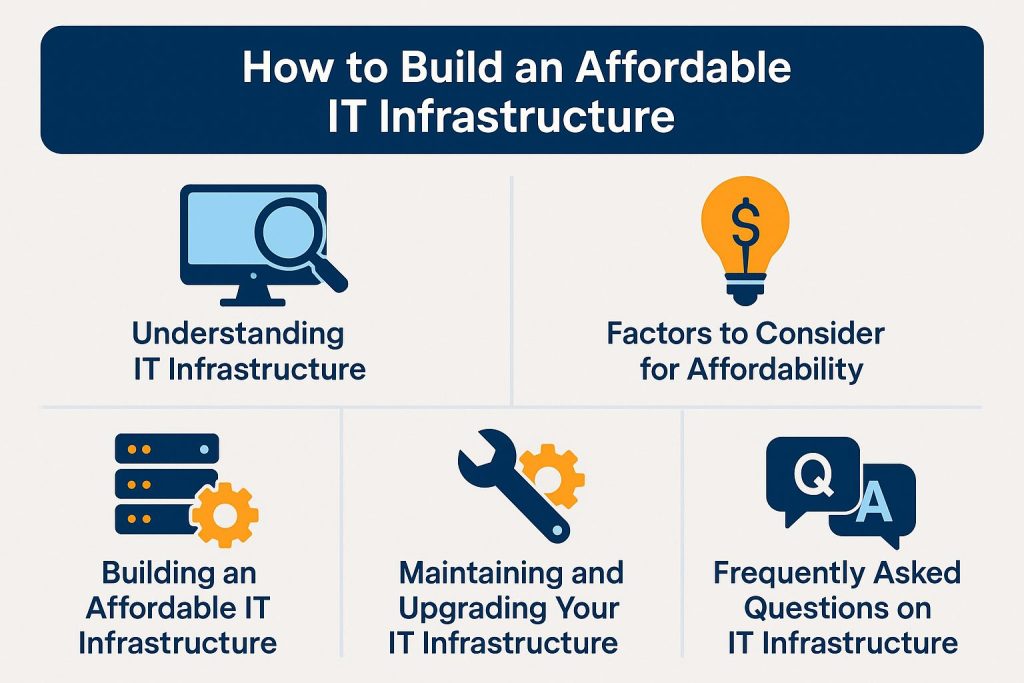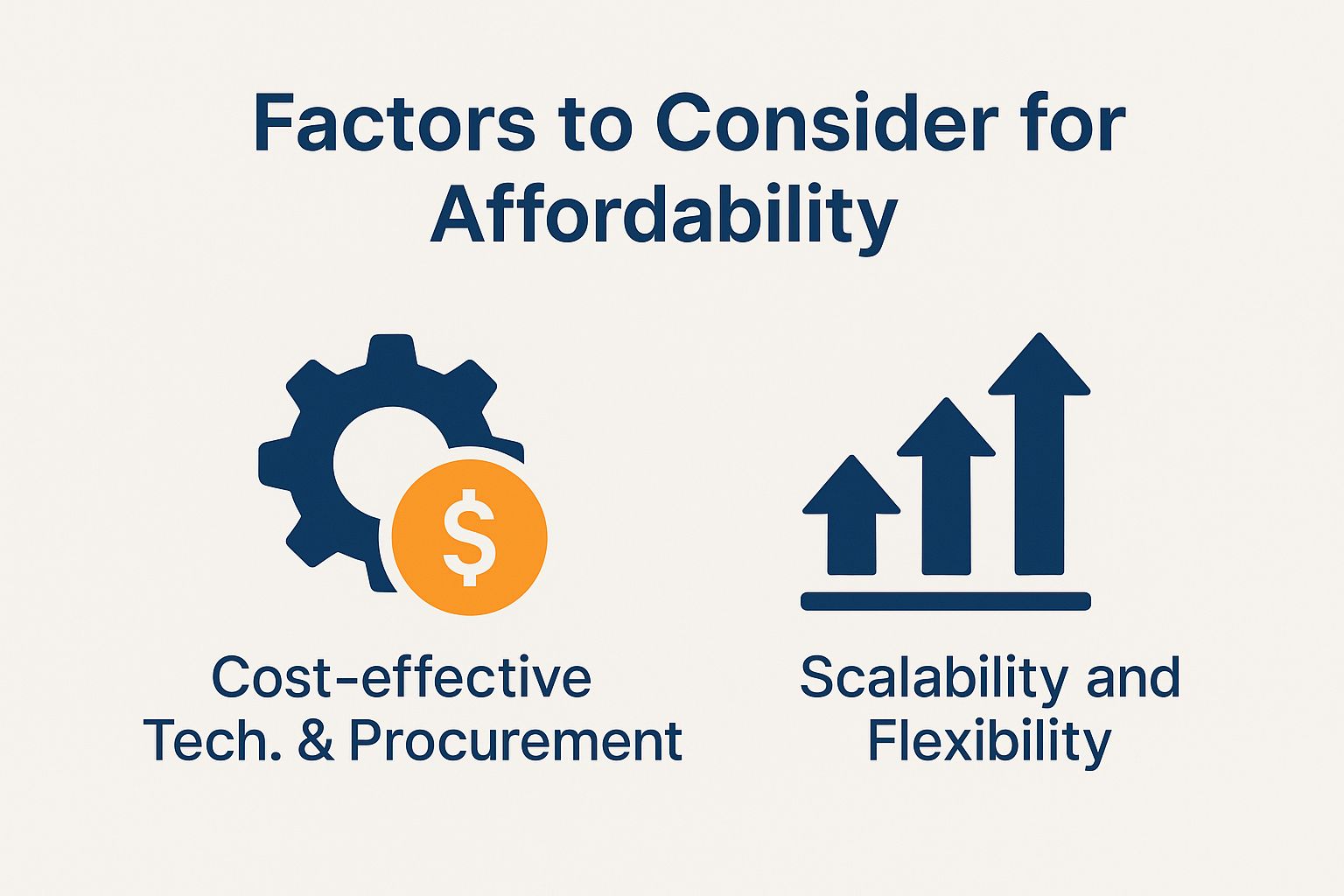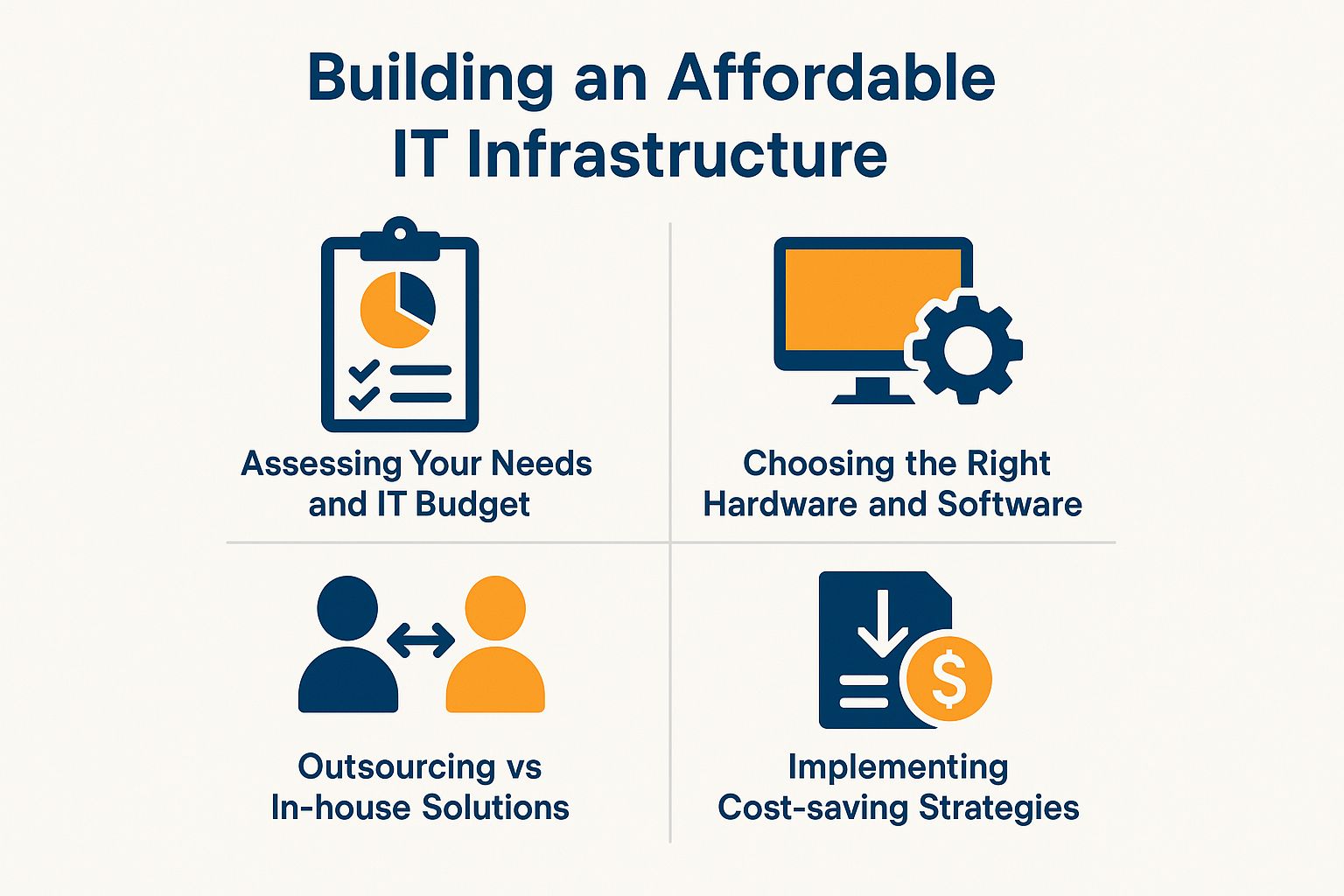How to Build an Affordable IT Infrastructure

Today, all businesses must understand IT infrastructure. A clear IT framework supports daily operations and is vital for growth. This article explores key parts of an affordable IT infrastructure: cost-effective technologies, scalability, and flexibility. It provides guidance on assessing organizational needs, selecting the appropriate solutions, and implementing strategies to maintain and upgrade systems efficiently. Readers will learn how to optimize their IT setup without high costs.
Understanding IT Infrastructure
IT infrastructure includes key components like hardware, software, networks, and data centers that support IT services. It helps organizations operate effectively and efficiently, especially with advanced technologies like cloud computing and virtualization. A proactive approach to IT security is critical- see also our guide on implementing a proactive IT security strategy-to protect these essential elements against potential threats.
A comprehensive understanding of these elements is essential for businesses seeking to implement cost-effective solutions while ensuring scalability and reliability in their IT operations.
Definition and Importance
This infrastructure is essential for business objectives. It supports data storage, helping organizations keep important information safe.
Good cybersecurity protects sensitive data from breaches. This builds customer trust and ensures compliance with regulations.
IT and technical support are crucial. They ensure systems run smoothly and quickly solve disruptions, keeping operations intact and business ongoing.
By investing in strong IT infrastructure, like server configuration and software-defined networking (SDN), boosts efficiency and prepares organizations for growth.
Factors to Consider for Affordability
Organizations planning affordable IT infrastructure should consider key factors that affect cost and efficiency. These factors are technology selection, IT budgeting, and long-term maintenance costs of IT services. Additionally, integrating managed IT services can significantly enhance the support for remote and hybrid workforces, which helps in maintaining cost-effectiveness and scalability over time. One of our hidden gems explores how managed IT plays a critical role in this aspect.

Cost-effective Technologies and Procurement
Cost-effective technologies, such as open source software and selected hardware, optimize IT infrastructure without sacrificing performance. Using remote access and collaboration tools increases flexibility.
These solutions help organizations cut operational costs while keeping productivity high. Open source software reduces licensing fees and offers flexibility in scalability, customization, and support.
For example, Linux offers a strong alternative to traditional operating systems, allowing businesses to perform better at lower costs.
For hardware, investing in energy-efficient devices like solid-state drives (SSDs) and virtualization solutions lowers energy use and boosts speed.
These decisions help firms streamline budgets and gain a competitive edge in today’s changing market by using infrastructure as a service (IaaS) and agile methods.
Scalability and Flexibility
Scalability and flexibility are essential for affordable IT infrastructure. They help organizations adapt to changing business needs without high costs.
These features help organizations allocate resources based on demand and smoothly integrate new technologies without major disruptions. Adding scalability to IT management helps companies avoid overprovisioning resources and unnecessary costs.
Cloud services improve adaptability. They allow organizations to scale dynamically based on changing operational needs. This boosts performance and fosters innovation, helping businesses respond quickly to market changes.
Building an Affordable IT Infrastructure
Building an affordable IT infrastructure requires a structured approach. This includes planning technology, consulting on IT, and creating an effective implementation strategy that fits the organization’s needs and budget. For businesses in Greensboro, our deep dive into affordable IT services offers tailored solutions that address local market challenges.

Assessing Your Needs and IT Budget
Assessing needs and budget is the first step in building an affordable IT infrastructure. It helps organizations align IT investments with strategic goals while managing costs.
By evaluating current and future technology needs, companies can prioritize spending. This ensures funds go toward the most impactful tools and services. This initial analysis provides a roadmap for effective resource allocation, enabling organizations to identify areas for cost savings without sacrificing quality.
Using techniques like cost-benefit analysis helps organizations foresee financial impacts and make informed decisions. Engaging stakeholders throughout this process encourages a comprehensive understanding of varying perspectives on IT needs, ultimately leading to a more robust and cohesive budget plan.
Choosing the Right Hardware and Software
Choosing the right hardware and software is crucial for a cost-effective IT infrastructure. It must meet performance needs and support business operations.
When selecting these components, consider criteria that affect their effectiveness. Performance monitoring helps organizations assess system operation under different workloads.
The installation processes for both hardware and software can vary significantly; ensuring proper setup can prevent future complications and enhance productivity. Compatibility is another crucial factor; the selected devices and applications must seamlessly connect with existing systems to avoid disruptions in workflows.
By taking these considerations into account, including network topology and internet of things (IoT) integration, organizations can build a robust IT environment that is both efficient and aligned with their strategic goals.
Outsourcing vs In-house Solutions
The decision between outsourcing IT functions and developing in-house solutions can significantly influence the affordability and efficiency of an organization’s IT infrastructure.
Deciding between outsourcing IT functions and in-house solutions greatly affects affordability and efficiency. Organizations weigh the benefits of outsourcing against the control in-house solutions provide.
On one side, managed services deliver flexible and scalable IT support, enabling businesses to concentrate on their core competencies while utilizing the latest technology and industry best practices.
On the other hand, investing in an in-house team can cultivate a deeper understanding of the organization’s specific needs, which may result in tailored solutions that align closely with business objectives.
Each approach presents its own set of merits and drawbacks, requiring a comprehensive evaluation of factors such as budget constraints, project timelines, and long-term strategic goals, guided by effective project management and IT consulting.
Implementing Cost-saving Strategies
Implementing cost-saving strategies is crucial for maintaining an affordable IT infrastructure. This includes optimizing performance with cloud resources and automation tools.
This requires a comprehensive approach that includes optimizing performance through the adoption of cloud computing resources and automation tools, which enhances scalability without incurring significant costs. Establishing a robust disaster recovery plan not only protects against data loss but also minimizes downtime, thereby conserving valuable resources.
Managing maintenance costs with contracts helps avoid unexpected expenses. This allows the organization to invest in future growth while keeping overheads low.
By adopting these strategies, organizations can thrive in a competitive landscape.
Maintaining and Upgrading Your IT Infrastructure
Maintaining and upgrading IT infrastructure is crucial for long-term efficiency and compliance with industry standards.
Focusing on enterprise architecture and infrastructure enhances performance and improves user experience and IT compliance.

Regular Maintenance and Updates
Regular maintenance and updates are essential for security and efficiency.
They keep the IT infrastructure secure, efficient, and aligned with the latest technology.
Without routine check-ups, systems may face security threats. This can lead to data breaches and operational disruptions. Staying current with the latest software patches and hardware upgrades significantly enhances performance, enabling organizations to utilize cutting-edge service capabilities.
In the fast-changing digital landscape, neglecting strategic planning and risk assessment can harm IT service delivery and business growth. Therefore, adopting a proactive approach to maintenance and updates safeguards assets and ensures optimal efficiency through continuous improvement.
Future-proofing Your System with IT Scalability
Future-proofing a system means evaluating current technologies, including open-source solutions. This ensures the IT infrastructure supports growth through scalability planning.
This process begins with a comprehensive analysis of existing systems, identifying strengths and weaknesses, and assessing how well these systems align with evolving business objectives. Engaging in a rigorous technology evaluation enables the integration of cutting-edge solutions that not only enhance performance but also provide the scalability necessary to accommodate changing demands.
Effective IT lifecycle management is crucial. It allows for timely upgrades and migrations while minimizing downtime. By adopting proactive maintenance practices and fostering a culture of continuous improvement, organizations can optimize their IT investments and effectively navigate the ever-changing technological landscape.
Frequently Asked Questions on IT Infrastructure
1. What exactly is an IT infrastructure and why is it important to build an affordable IT infrastructure for my business?
An IT infrastructure refers to the collection of hardware, software, networks, and services that are necessary for an organization to use and manage information effectively. It is important to build an affordable IT infrastructure for your business as it enables efficient communication, collaboration, and data management, which are crucial for success in today’s digital age.
2. Where do I start when building an affordable IT infrastructure with energy efficiency?
The first step is to assess your business needs and objectives. This will help determine the type of hardware, software, and network infrastructure you require. Next, research and compare prices from different vendors to find the most cost-effective solutions. You can also consider using cloud services to reduce hardware and maintenance costs.
3. Can I build an IT infrastructure on a budget with outsourcing IT?
Yes, building an affordable IT infrastructure is possible. With careful planning and strategic decision-making, you can create a budget-friendly infrastructure that meets your business needs. It may require a bit more effort and research, but it will save you money in the long run.
4. Do I need to hire an IT professional or seek IT support to build my infrastructure?
It is not necessary to hire an IT professional, but it is highly recommended. An experienced IT professional can help you make informed decisions, implement the infrastructure effectively, and troubleshoot any issues that may arise. This can save you time and money in the long run.
5. How can I ensure the network security of my affordable IT infrastructure?
Security is a top priority when building IT infrastructure. Invest in reliable antivirus and firewall software. Conduct regular backups. Implement strong password policies. Train your employees on cyber safety. Regularly update your systems.
6. Can I upgrade my IT infrastructure for scalability as my business grows?
Yes, it is possible to upgrade your IT infrastructure as your business grows. Plan for scalability when building your infrastructure. This includes choosing hardware and software that can be easily upgraded. Consider future business needs when designing your network infrastructure.


